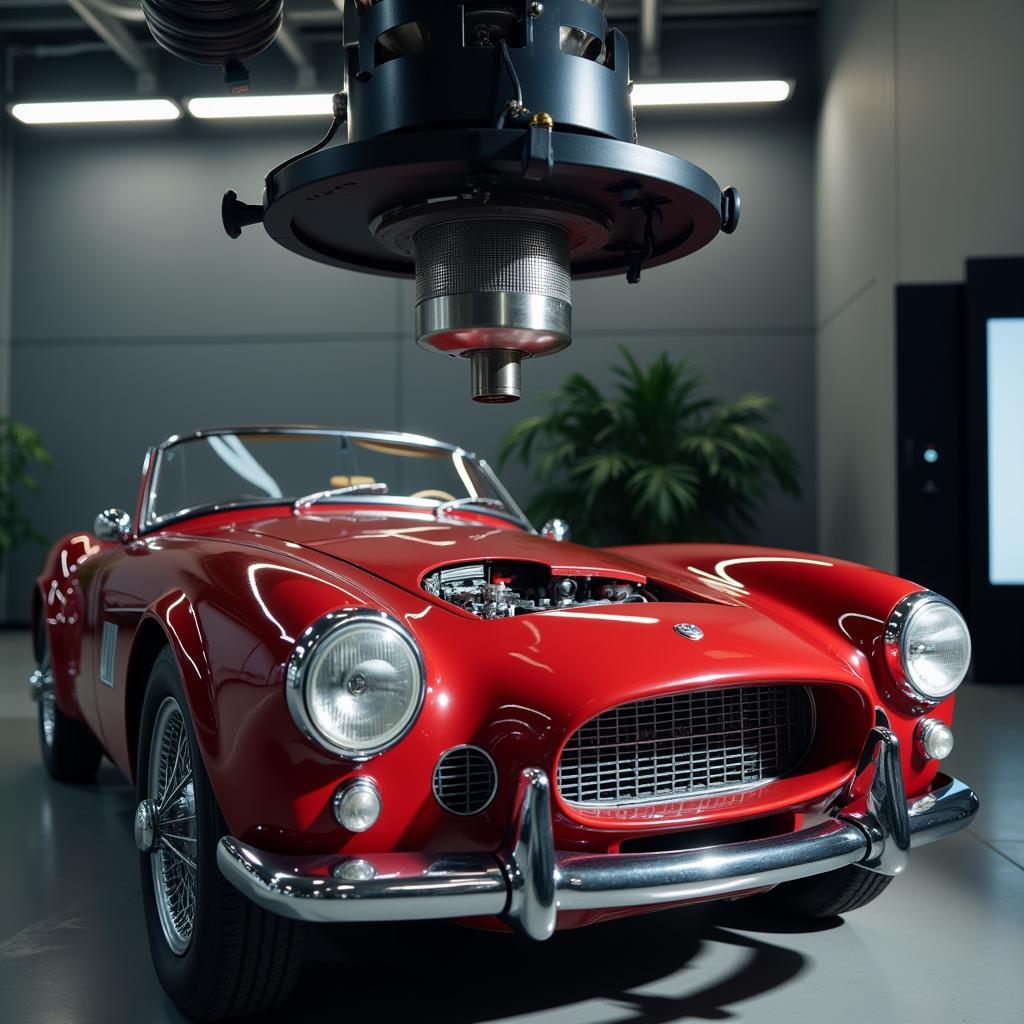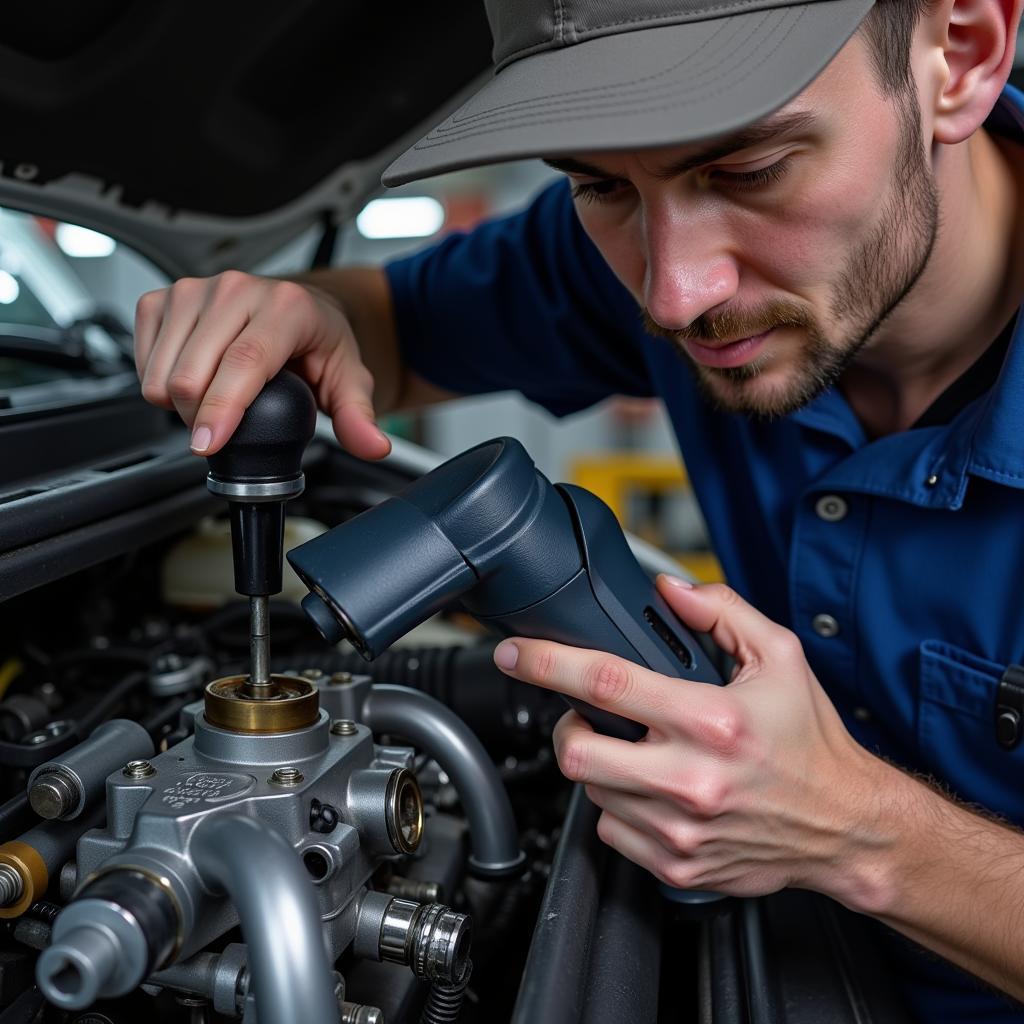The automotive industry is rapidly evolving, with technology driving significant advancements in vehicle design and repair processes. At the forefront of this revolution is the “3d Scanning Reverse Engineering Tool,” a game-changer for mechanics and restoration enthusiasts alike. This innovative technology enables the creation of precise digital models of car parts, even those no longer in production, making it possible to reproduce them with incredible accuracy.
 3D scanning a car part for reverse engineering
3D scanning a car part for reverse engineering
What is 3D Scanning Reverse Engineering?
Reverse engineering traditionally involved disassembling and meticulously measuring parts to understand their design. 3D scanning revolutionizes this process. It uses lasers or structured light to capture millions of data points on an object’s surface, creating a detailed 3D model. This digital blueprint can then be used to analyze the part’s geometry, tolerances, and design intent, ultimately enabling the production of identical replicas.
Advantages of Using 3D Scanning in Automotive Repair
Unmatched Precision for Perfect Fit
Traditional measurement methods often lack the precision required for complex parts, leading to fitment issues. 3D scanning eliminates this problem by capturing minute details, ensuring the replicated part fits perfectly the first time.
Breathing Life into Obsolete Parts
Sourcing parts for classic or rare cars can be a nightmare. 3D scanning offers a solution by allowing the creation of new parts from existing ones, even if the original manufacturer no longer exists.
 Restoring a classic car with 3D scanning technology
Restoring a classic car with 3D scanning technology
Streamlining the Design and Manufacturing Process
3D scanning accelerates the design and manufacturing of custom parts. Mechanics can modify the digital model, make improvements, and seamlessly transfer it to a 3D printer or CNC machine for production.
Significant Cost and Time Savings
By eliminating the need for multiple prototypes and reducing labor-intensive measurements, 3D scanning significantly cuts down production costs and lead times.
Applications in Automotive Repair
Restoration of Classic Cars
3D scanning is a godsend for vintage car enthusiasts, allowing them to recreate discontinued parts with original manufacturer accuracy, preserving the authenticity of their prized possessions.
Customized Part Manufacturing
From bespoke body kits to unique interior components, 3D scanning empowers mechanics to design and produce customized parts that meet their specific requirements.
Accident Damage Repair
3D scanning aids in the accurate assessment of accident damage and assists in creating perfectly fitting replacement panels, restoring vehicles to their pre-accident condition.
Choosing the Right 3D Scanning Reverse Engineering Tool
Selecting the appropriate 3D scanner depends on the specific application and budget. Consider factors like accuracy, resolution, scanning speed, and portability when making a decision.
“Investing in the right 3D scanning technology can significantly enhance your capabilities as a mechanic,” says John Miller, a veteran automotive engineer with over 20 years of experience. “The ability to reverse engineer parts opens up a world of possibilities for tackling complex repairs and restorations.”
 Mechanic using 3D scanner to reverse engineer an engine part
Mechanic using 3D scanner to reverse engineer an engine part
The Future of Automotive Repair is Here
3D scanning reverse engineering tools are transforming the automotive repair landscape. This technology empowers mechanics with unparalleled precision, efficiency, and flexibility, enabling them to tackle complex repairs, preserve automotive history, and meet the growing demand for customization.
Contact ScanToolUS today at +1 (641) 206-8880 or visit our office at 1615 S Laramie Ave, Cicero, IL 60804, USA, to explore how 3D scanning can revolutionize your automotive repair business.
Frequently Asked Questions
What is the accuracy of 3D scanning in reverse engineering?
Modern 3D scanners can achieve accuracy levels of up to 0.01 mm, ensuring highly precise digital models for reverse engineering.
Is 3D scanning suitable for all types of car parts?
3D scanning can be used for a wide range of parts, from simple brackets to complex engine components. However, highly reflective or transparent surfaces may require specialized scanning techniques.
How long does it take to 3D scan a car part?
Scanning time depends on the part’s size and complexity, ranging from a few minutes to several hours for large or intricate objects.
What software is used for 3D scanning reverse engineering?
Various software programs are available for processing 3D scan data and creating CAD models for reverse engineering, such as Geomagic Design X, PolyWorks, and Autodesk ReCap.
What are the cost implications of using 3D scanning in automotive repair?
While the initial investment for 3D scanning equipment can be significant, the long-term benefits in terms of time savings, reduced labor costs, and increased accuracy often outweigh the upfront expenses.
